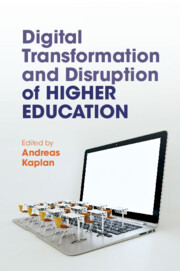Book contents
- Digital Transformation and Disruption of Higher Education
- Digital Transformation and Disruption of Higher Education
- Copyright page
- Contents
- Figures
- Tables
- Contributors
- Preface
- Chapter 1 Nothing Is Constant Except Change
- Part I (R)evolution of the Higher Education Sector
- Part II Changes in Teaching Formats
- Chapter 7 Contemporary Changes in Teaching Formats
- Chapter 8 Digital Transformation in Teaching and Learning
- Chapter 9 Blending Emerging Technologies for Student-Centred Teaching
- Chapter 10 Artificial Intelligence
- Chapter 11 Quality Assurance and Enhancement
- Part III Changes in Teaching Content
- Part IV Networking and Social Activities
- Part V Certification and Diplomas
- Part VI Careers and Professionalisation
- Part VII Futuristic and Ultramodern Higher Education
- Part VIII Higher Education in Motion
- Editor’s Biography
- Index
- References
Chapter 9 - Blending Emerging Technologies for Student-Centred Teaching
A Critical Analysis
from Part II - Changes in Teaching Formats
Published online by Cambridge University Press: 09 June 2022
- Digital Transformation and Disruption of Higher Education
- Digital Transformation and Disruption of Higher Education
- Copyright page
- Contents
- Figures
- Tables
- Contributors
- Preface
- Chapter 1 Nothing Is Constant Except Change
- Part I (R)evolution of the Higher Education Sector
- Part II Changes in Teaching Formats
- Chapter 7 Contemporary Changes in Teaching Formats
- Chapter 8 Digital Transformation in Teaching and Learning
- Chapter 9 Blending Emerging Technologies for Student-Centred Teaching
- Chapter 10 Artificial Intelligence
- Chapter 11 Quality Assurance and Enhancement
- Part III Changes in Teaching Content
- Part IV Networking and Social Activities
- Part V Certification and Diplomas
- Part VI Careers and Professionalisation
- Part VII Futuristic and Ultramodern Higher Education
- Part VIII Higher Education in Motion
- Editor’s Biography
- Index
- References
Summary
Student-centred learning is an emerging terminology questioning the relevance of traditional terminologies such as teacher-centred and institution-centred learning. Teacher-centred and institution-centred learning align more towards teachers and institutions making the students passive recipients of knowledge. These traditional paradigms of teaching have been questioned in recent years and they have been replaced by student-centred learning which focuses on placing the students at the forefront and taking responsibility for their learning. Internet technology has offered tremendous support in the process of students playing a key role in student-centred learning. This chapter presents a summary of emerging technologies that have played a key role in enhancing the quality of student-centred learning in higher education. Five key technology trends such as Learning Management Systems, Virtual Reality, Internet of Things, MOOCs and Social Media are critically analysed to explore their role in the development of a student-centric learning and teaching program. The chapter identifies the strengths and weaknesses of these technologies and how they can be successfully applied to enhance the quality of student-centric learning and teaching program.
Keywords
Information
- Type
- Chapter
- Information
- Digital Transformation and Disruption of Higher Education , pp. 102 - 119Publisher: Cambridge University PressPrint publication year: 2022
References
Accessibility standard: Unknown
Why this information is here
This section outlines the accessibility features of this content - including support for screen readers, full keyboard navigation and high-contrast display options. This may not be relevant for you.Accessibility Information
- 1
- Cited by
